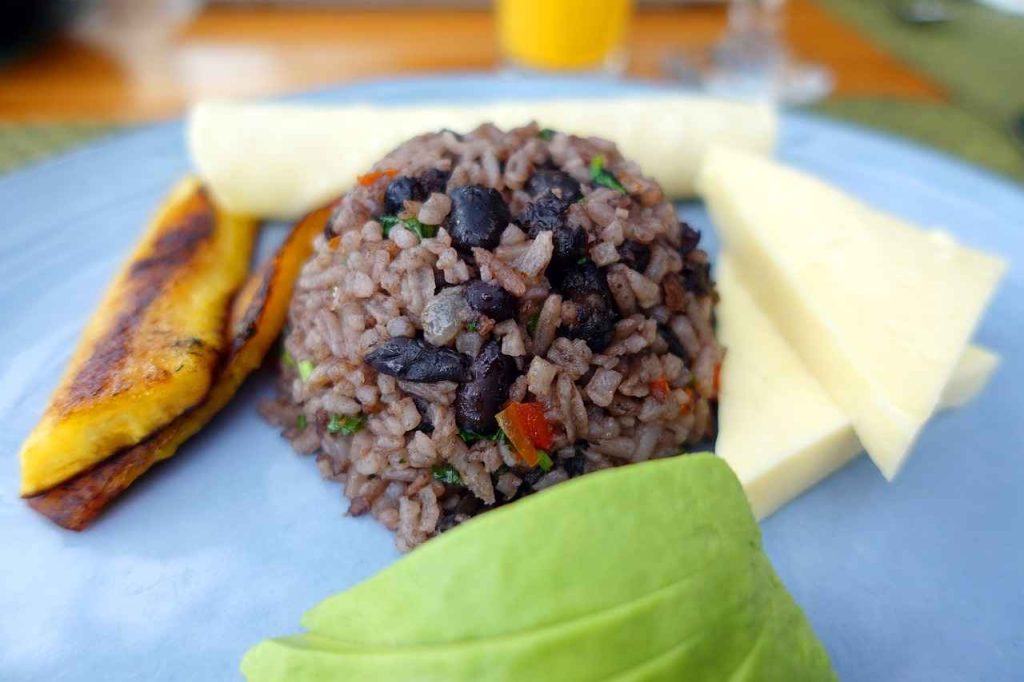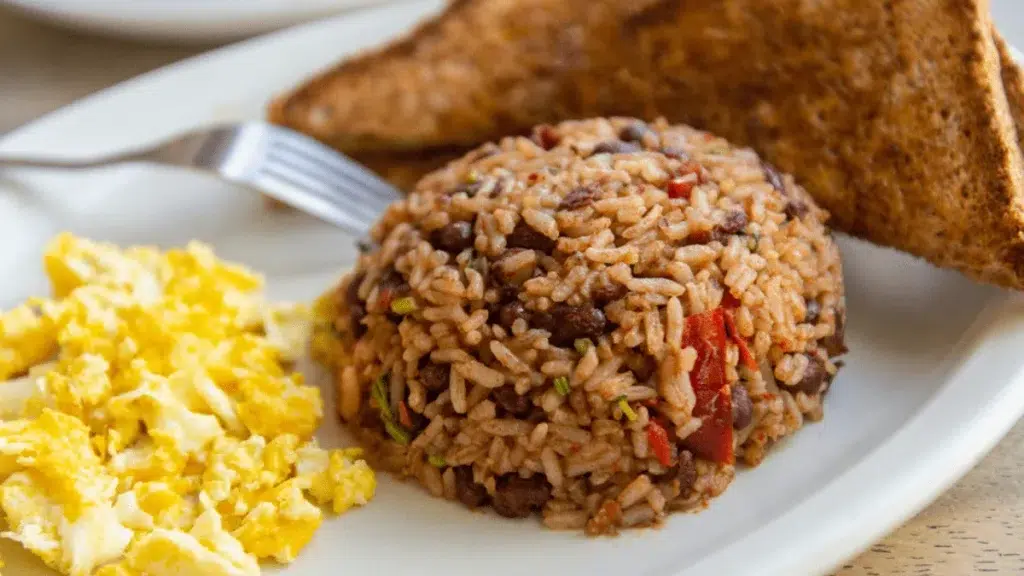If you’ve ever strolled through the bustling markets of San José or savored breakfast in a tranquil Costa Rican beach town, you’ve likely encountered this delightful dish. But have you ever wondered where these Costa Rican rice and beans originated?
How did this simple yet tantalizing mix of rice and beans become the heart and soul of Costa Rican cuisine? Let’s dive into its colorful origins and explore its recipe!

The Origins of Gallo Pinto, Costa Rica
The true origin of Gallo Pinto is as speckled as the dish itself. While its roots are undoubtedly in Central America, Costa Rica and its neighbor, Nicaragua, lovingly claim it as their own. The age-old debate rages on, with both nations sharing tales of its birth within their borders.
However, irrespective of where it truly began, the fact remains that Gallo Pinto is deeply woven into the fabric of Costa Rican culture.
Some historians believe that Gallo Pinto traces its lineage back to when enslaved Africans were brought to the Spanish colonies. They point to the African tradition of mixing grains with available ingredients, a culinary practice that might have beautifully blended with Spanish and indigenous recipes.
Others argue that the dish has indigenous roots, evolving from the rich agricultural traditions of Central America.
But here’s the golden nugget of truth: while its origins might be debated, the universal love for Gallo Pinto isn’t. The dish’s beauty lies in its simplicity and adaptability.
What does gallo pinto mean in Costa Rica?
At first glance, the name “Gallo Pinto” might seem a bit puzzling. Directly translated, it means “spotted rooster” in English. You’d be forgiven for wondering what roosters have to do with rice and beans.
Ticos refer to Gallo Pinto or Pinto as a combination of rice and beans cooked with Lizano sauce, coriander, and sweet pepper, among other ingredients.
The name captures the dish’s essence: the dark beans’ speckled, almost “spotted” appearance against the white rice grains. It visually resembles the contrasting colors of a spotted rooster, a familiar sight in the Costa Rican countryside.
It is called Gallo Pinto because when the beans and rice come together, the rice acquires the color of the beans, and the mixture becomes multicolored. Usually, Costa Ricans use black beans, but the dish has variations, and many prefer red beans.
Gallo Pinto Recipe
This rice and bean dish is comfort food, Costa Rican style! Here’s how to whip up the authentic gallo pinto step by step:
Ingredients:
- 2 cups of cooked white rice (leftover rice from last night’s dinner works wonders!)
- 1 cup of cooked black beans with some of its liquid (you might replace it with canned beans)
- 1 medium onion, finely chopped
- 1 red bell pepper (any color will do!), chopped
- 2-3 cloves of garlic, minced
- 2 tablespoons of vegetable oil (or any cooking oil you have on hand)
- 1-2 teaspoons of Costa Rican salsa, Lizano. Don’t fret if you don’t have it. Worcestershire sauce or soy sauce can be handy substitutes, although the taste will differ slightly.
- Salt and pepper to taste
- Optional: fresh chopped cilantro for an herbal twist and garnish!
Let’s Get Cooking!
- Saute away: Heat the oil in a large pan or skillet over medium heat. Add the chopped onion, bell pepper, and minced garlic. Saute these goodies until they’re soft and fragrant, roughly 3-4 minutes.
- Bean there, done that: Stir in the black beans. Don’t forget a bit of the bean liquid – it’s the secret to getting that rich, authentic flavor! Mix everything well and let it simmer for about 2 minutes.
- Rice to the occasion: Gently fold in your cooked rice. Stir everything, ensuring the beans and sautéed veggies are evenly distributed. You want every bite to be a mini flavor explosion!
- Saucy secrets: Drizzle in the salsa Lizano (or your substitute). This magical potion will tie all the flavors together.
- Season and stir: Sprinkle in salt and pepper according to your taste buds. Give everything a good mix, and let it cook for another 3-5 minutes until it’s all heated.
- Garnish & serve: If you’re using fresh cilantro, sprinkle some on top. Serve your Gallo Pinto hot, and enjoy! Pair it with a fried egg, sour cream, or fried plantains for a fuller meal. You can also add your preferred hot sauce for a more complex flavor.
And voila! You’re ready to eat gallo pinto. ¡Buen provecho!
Salsa Lizano, the essence of Gallo pinto, Costa Rican style
Traditional Gallo Pinto is always cooked with Lizano sauce, making this dish a Costa Rican one. There is a saying in Costa Rica that says: “Donde hay salsa Lizano, hay un Tico.” This translates to “Where there is Lizano sauce, there is a Tico.”
The Lizano sauce, also called Salsa Inglesa (it’s a kind of Worcestershire sauce), is the pride and culinary joy of Costa Rica. For almost 90 years, Lizano sauce has been a staple on every table and in every home. It has also captured the taste buds of travelers from around the world.
Variations
There are other variations of this dish. A similar dish is found in Panama and El Salvador, where it is called Casamiento (Wedding). It is also known as Moros y Cristianos (“Moors and Christians”) or just Moro in Spain and Cuba. But, regarding the true nature of Gallo Pinto, it is believed that it came to be known through the Afro-Latino immigrants who live on the Caribbean Coasts. In Costa Rica’s Limón Province, the dish is prepared with coconut and is called “rice and beans.”
Gallo Pinto: A Taste of Costa Rica in Every Bite!
Ready to whisk your taste buds away on a Costa Rican adventure without leaving your kitchen? Say “¡Hola!” to Gallo Pinto, the sunrise staple of this tropical paradise.
Let the passionate team at Find My Costa Rica guide you. Discover secret local spots, indulge in authentic culinary experiences, and let Gallo Pinto be the beginning of your Costa Rican journey.
Embark on your Costa Rican adventure and let your taste buds lead the way! Book your trip now with Find My Costa Rica!

FAQ
- Is Gallo Pinto eaten at a specific time of day?
Gallo Pinto is a sunrise superstar, often enjoyed as a hearty breakfast. But its charm isn’t confined to mornings; you’ll spot it at lunch or dinner tables too!
- Is Gallo Pinto vegetarian/vegan-friendly?
Absolutely! Gallo Pinto’s core ingredients are rice and beans, making it a vegan delight. Just double-check any added toppings or sides if you’re dining out.
- What’s the main difference between Costa Rican ‘Gallo Pinto’ and Nicaraguan ‘Gallo Pinto’?
Both are tasty, but they dance to different tunes! Costa Rica typically uses black beans, while Nicaragua often opts for red beans. Also, the seasoning and accompaniments might vary.
- Can I find ‘Gallo Pinto’ at all Costa Rican restaurants?
Oh, for sure! Gallo Pinto proudly graces menus across Costa Rica, from bustling city cafes to serene beachside shacks. It’s a national favorite!



